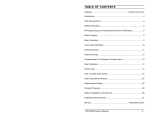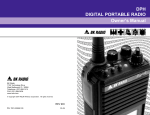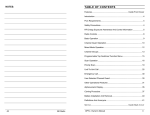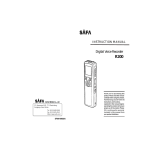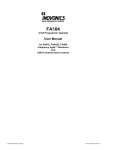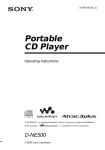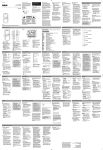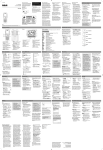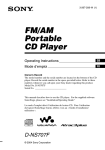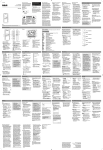Download BK Radio GPH FlexoMode Service manual
Transcript
SECTION III OPERATION 3.1 INTRODUCTION This section contains information concerning the operation procedures for the BK Radio GPH Flex•Mode Series handheld VHF radios. Information on installation and programming is contained in Section 2 of this manual. WARNING WARNING DO NOT OPERATE THE TRANSMITTER IN CLOSE PROXIMITY TO BLASTING CAPS DO NOT OPERATE THE RADIO IN AN EXPLOSIVE ATMOSPHERE (PETROLEUM FUELS, SOLVENTS, DUST, ETC.). 3.1.1 Display Options GPH Series Radios can be equipped with a standard 7-Segment Display, an Alphanumeric Display, or no display at all. Radios with either a 7-Segment Display or an Alphanumeric Display are also equipped with a keypad, and can be programmed to operate on one or more channel groups. Radios with a keypad and display have a slide-out keypad cover. To remove or install the cover, turn off the radio and remove the battery (see Battery Installation, page 2-1). An Alphanumeric Display shows channel and scanning information in a different way from a 7-Segment Display. The annunciators across the top of the display are arranged differently, but convey the same meaning. An Alphanumeric Display can also show letters, instead of just numbers. Radios with an Alphanumeric Display can be programmed to operate in 7-Segment mode (see Section 2.2.5.3). The channel and scanning information will appear in the same way as a 7-Segment display, but the annunciators are still different. Display annunciators indicate the following information: 7-Segment Alphanumeric Indication PR PR Priority Channel PROG PRG Programming Mode (includes PR) SCAN SCN Scan List Channel (On Alphanumeric Display, flashing SCN indicates Scanning in progress, and RX SCN indicates Receiving on a Scanned channel.) TX TX Transmit RX RX Receive ID ID Automatic Numeric Identification (ANI) Programming mode only CG CG User Code Guard GRP Group Label Programming mode only Programming mode only Alphanumeric Display only Page 3-1 Operation GPH Series VHF Radio PRG TX RX SCN ID CG G R P 7-SEGMENT DISPLAY ALPHANUMERIC DISPLAY FIGURE 3-1 Liquid Crystal Displays 3.2 BASIC OPERATION Operating procedures are basically the same for all three display types (7-Segment, Alphanumeric, and no display), with some obvious differences. For example, a radio with no display or keypad has no keys to press. The actual display on the radio may appear different from the illustrations, depending on the features installed and programmed in the radio. 3.2.1 Receive Turn unit on by turning the Volume knob clockwise past the OFF detent. The radio will beep, indicating that it has passed its self test and is operational. CG- SQ A B OFF- VOL 6 5 4 3 C 7 8 9 10 11 12 13 14 2 1 16 15 Select a channel by turning the 16-position Channel Selector knob. Adjust squelch and volume by turning the squelch knob clockwise until you hear noise. Set the volume to a comfortable level. Then turn the squelch knob counterclockwise until the noise stops. This is called the threshold squelch setting. CG- OFF- SQ 7 A B C 8 VOL 9 10 6 11 3 14 12 5 4 13 2 1 16 15 Turning the squelch knob fully counterclockwise past the detent places the receiver in Code Guard™ mode. A message will be heard only when the proper Code Guard value is received. 3.2.2 Transmit Monitor the Channel before transmitting. If in Code Guard Mode, turn the Monitor-Squelch knob clockwise off the detent position. Press and hold the PTT (Push To Talk) switch. If a Speaker/Microphone is installed, use the Speaker/Microphone's PTT. When the transmitter is on, the red Transmit Indicator glows and the TX annunciator on the LCD appears. Talk in a normal voice with the microphone two to three inches from your mouth. Release the PTT switch to stop transmitting. If the transmit indicator does not glow when you press the PTT switch, the battery pack may need to be charged. If so, the display will indicate LOBATT, and the yellow low-battery indicator will flash. If the transmit indicator does not glow and a tone sounds, you are on a receive-only channel or the channel is busy (if busy channel lockout is enabled). Select an authorized transmit channel. If the length of the message exceeds the preset time-out timer setting, the transmitter automatically shuts off and a tone sounds. To continue transmission, release the PTT switch, and then press it again and continue talking. * Code Guard™ is a trademark of BK Radio. Page 3-2 GPH Series VHF Radio Operation 3.2.3 Code Guard Operation Code Guard™ allows one radio or group of radios to be selectively called within a system. If the radio has been programmed with Code Guard, use the following receive and transmit instructions. Code Guard™ is a trademark of BK Radio. 3.2.3.1 Code Guard Receive Turn power on by turning the volume knob clockwise. Select a Code Guard channel by turning the channel selector knob. CG- OFF- VOL SQ 8 9 7 A B C 10 6 11 3 14 5 12 4 13 2 1 16 15 Adjust volume by turning the squelch knob clockwise until you hear noise. Set the volume to a comfortable level, then turn the squelch knob counterclockwise until the noise stops. (Threshold squelch setting) Set Code Guard mode by turning the squelch knob off (counterclockwise) into the Code Guard position. A message will be heard only when the proper Code Guard value is received. 3.2.3.2 Code Guard Transmit CG- SQ OFF- VOL 7 A B 8 9 10 6 5 4 3 C 2 1 16 3.2.4 11 12 13 14 15 Before transmitting on Code Guard channels, monitor the channel by turning the squelch knob clockwise, off the detent. If the channel is not busy, press and hold the PTT switch. Reset the squelch knob to the Code Guard position to receive only the messages with the proper Code Guard value. During extended transmissions, the squelch can be left open until the exchange has ended. Channel Selection Radios with more than 16 channels are separated into groups of 16 channels each. Each group of 16 channels can be programmed to have an "individual personality" with its own set of operational features. The group/channel selector knob can be programmed by your dealer as a channel selector, a group selector, or a custom group/channel selector. A. Channel Selector 6 5 4 3 7 8 9 10 2 1 16 11 12 13 14 15 Knob positions 1-16 select channels in the group selected by the keypad. 1. Press the [#] key on the keypad to display the current group number. 2. Press a number key for the new group number. Only valid group entries will be accepted. For, example, if your radio only has five channel groups programmed, digits greater than five will be ignored. When changing groups, invalid entries will not be accepted, and the radio remains in the previously selected group. 3. Press the [ENT] key or wait 5 seconds. The radio returns to normal operation for the new group, and the selected channel is displayed. All selected scanning and priority functions affect only the channels in the group you are operating in. Page 3-3 Operation GPH Series VHF Radio B Group Selector Knob positions 1-16 select groups 1-15. 1 2 3 FCN 4 5 6 PRI 7 8 9 ENT * 0 # CLR 1. Press [#] twice to select a channel. 2. Press a number key for the new channel number. 3. Press the [ENT] key or wait 5 seconds. The radio returns to normal operation for the new channel, and the selected group is displayed. C. Custom Selector Your dealer will provide you with the pre-programmed group/channel combinations for your radio. If a knob position is programmed to allow selection of the group and/or channel with the keypad: 1 2 3 FCN 4 5 6 PRI 7 8 9 ENT * 0 # CLR 1. Press [#]. 2. Press the number of the group you want to change to. 3. Press the [ENT] key or wait 5 seconds. 4. Press [#] twice. 5. Press the number of the channel you want to change to. 6. Press the [ENT] key or wait 5 seconds. If the group or channel is locked to a switch position, pressing [#] will only display the pre-programmed knob-assigned value. New entries will not be accepted. 3.2.5 Programmable Top Switches/Function Menu A B The three top switches, labeled A, B, and C, can be programmed by your dealer for channel scan, dual priority scan, group scan, low-power select, and RTA (Repeater Talk Around). Your dealer can also assign two functions to the same switch. For example, both low-power select and RTA could be enabled by the same switch. C 1 2 3 FCN Any functions not assigned to a top switch can be enabled/disabled with the keypad [FCN] key. 4 5 6 PRI Press the [FCN] key to display the function menu. 7 8 9 ENT * 0 # CLR Press [PRI] to toggle the function on/off when the desired menu item is displayed. Repeatedly press [FCN] to step through the menu. When the display flashes, the function is enabled. NOTE: Assume for this service manual that Switch A has been programmed for HI/LO transmit power, Switch B has been programmed for Scan, and Switch C has been programmed for Priority Scan. Page 3-4 GPH Series VHF Radio 3.3 Operation SCAN OPERATION 3.3.1 Receive Scan operates only while the radio is not transmitting. The radio checks for signals on channels in the preset scan list, as well as the channel selected by the channel selector knob. When a signal is detected, scanning stops and the message is received. The received channel is shown in place of the transmit channel. Once the signal ends, the radio continues to monitor the channel for the preset scan delay time before it resumes scanning. 3.3.1.1 Basic Scan A B C 1. Slide Switch B (scan) up. 2. Slide Switch C (priority) down. The display indicates scan operation by flashing the SCN annunciator (Alphanumeric display) or by flashing bars (7-Segment display). 3.3.1.2 Scan Code Guard Channels A B C 1. Slide Switch B (scan) up. 2. Turn the squelch knob completely counterclockwise, past the detent, to the Code Guard position. When a signal is detected, scanning stops while the radio checks for the proper Code Guard value. If the signal contains the proper Code Guard value, the radio receives the message. Otherwise, the radio resumes scanning immediately. 3.3.1.3 Nuisance Channel Delete If your radio is programmed for nuisance channel delete and channel scan is assigned to a top switch (Switch B, for example), a nuisance channel can be temporarily removed from the scan list by sliding Switch B down and then back up. Page 3-5 Operation GPH Series VHF Radio 3.3.2 Transmit With Scan On When Switch B (scan) is up, the radio transmits on the channel selected by the channel selector knob. 1. Select a transmit channel by turning the channel selector knob. 2. Press and hold the PTT switch and talk in a normal voice. When the PTT switch is released, the radio continues to monitor the selected channel for the preset scan delay time before it resumes scanning. 3.3.2.1 Talkback Scan If your radio is programmed for Talkback Scan, press PTT while a channel is active or while scan-delay time remains. You will be responding on the transmit frequency of the received channel. Talkback Scan will not work if Priority Scan is also on and your radio is programmed to always transmit on the Priority 1 channel. Page 3-6 GPH Series VHF Radio Operation 3.3.3 Change the Scan List The radio can be programmed to enable the user to add or remove channels from the scan list. If user changes are enabled, follow these steps to change the scan list: A B C 1. Slide Switches B (scan) and C (priority) down. 2. Select a channel to be added or removed from the scan list by turning the channel selector knob. If the channel is already on the scan list, SCN appears in the display. 3. Press the [ENT] key to add a channel to the scan list. A short beep sounds and SCN appears in the display. 4. Press the [CLR] key to remove a channel from the scan list. A short beep sounds and SCN disappears from the display. 3.3.4 Fix the Scan List See Scan List Lockout in Section 2 if you want to program the radio so that the user cannot alter the scan list. 3.4 PRIORITY SCAN Priority scan enables the radio to receive on any channel while monitoring for a message on the designated priority channel(s). The radio samples each priority channel at a preset rate (.25-2.0 seconds) regardless of activity on any other channel. Priority scan operates only while the radio is not transmitting and can be used in combination with scan operation. When Switch C (priority) is up, the display flashes SCN. If a message is received on a priority channel, the priority indicator lights, and the radio receiver locks onto that channel for the duration of the transmission, unless a higher priority channel interrupts. Priority Scan can be used in combination with Code Guard with: CG- SQ OFF- VOL 7 A B C 6 5 4 3 8 Switch C up The squelch knob in the Code Guard position (off) and The priority channel(s) programmed with Code Guard 9 10 11 12 13 14 2 1 16 15 If a message is received on a priority channel, the radio receiver locks on to the priority channel and checks to see if the proper Code Guard value is present. If the signal contains the proper Code Guard value, the radio receives the message. Otherwise, the radio will re-check the channel every 4 seconds, until the activity on the channel ceases. Page 3-7 Operation GPH Series VHF Radio 3.4.1 Dual Priority Scan In each group, up to two of the sixteen channels can be designated as priority channels. These two, PR1 and PR2, are periodically tested for activity, even if a different transmission is being listened to. Activity on PR2 preempts activity on any of the non-priority channels. Receptions on PR1 have priority over any other channel in the group, including PR2. Either priority channel can be programmed as a fixed channel, tied to the Channel Selector knob, or programmed OFF. If the radio is programmed to transmit on the first priority channel, transmissions will occur on PR1, if PR1 isn’t programmed OFF, when operating in Dual Priority Scan mode. If PR1 is a fixed channel, and the [PRI] key is not locked out, the user can move the channel selector to a new channel and press the [PRI] key to choose a new PR1 channel. Dual Priority Scan is automatically disabled when Group Scan is on. 3.4.2 Old-Style BK Priority Scan The radio can be programmed with one of three priority modes: A, B, or C. The table below shows how the priority channel and the transmit channel are selected in each mode. Mode A Mode B Mode C Priority Channel Channel Knob Preset Preset Transmit Channel Channel Knob Channel Knob Priority Channel 3.4.2.1 Priority Mode A In Priority Mode A, the priority channel is set by the channel selector knob. Priority Mode A is seldom used by itself because the radio receives and transmits only on the knob-selected channel. When scan and Priority Mode A are enabled, scanning occurs until an active scan channel is found. The radio receives the message while continuing to check the priority (knob-selected) channel. The display shows the scan channel. If the priority channel becomes active during this message, the priority indicator lights. The radio changes to the priority channel and holds for the duration of the message. The display shows the priority channel. To reply to a message on the priority channel, press the PTT switch and transmit on the priority channel. Once activity ceases on the priority channel, the radio returns to scan operation. Page 3-8 GPH Series VHF Radio Operation 3.4.2.2 Priority Mode B With Switch C (priority) up and Switch B (scan) down, the radio can receive on the knob-selected channel while sampling the priority channel. If the priority channel becomes active, the priority indicator lights. The radio changes to the priority channel and holds for the duration of the transmission To reply to a message on the priority channel, turn the channel selector knob to the priority channel, and then transmit. With Switches B (scan) and C (priority) up, the radio scans until it locks on to an active channel. The radio continues to sample the priority channel while listening to the active scan channel. If activity occurs on the priority channel, the radio overrides the active scan channel, changes to the priority channel, and holds for the duration of the transmission. To reply to a message on the priority channel, turn the channel selector knob to the priority channel, and then transmit. Once activity has ceased on the priority channel, the radio returns to scan operation. 3.4.2.3 Priority Mode C With Switch C (priority) up and Switch B (scan) down, the radio samples the fixed priority channel at the preset rate. If activity occurs on the priority channel, the radio changes to the priority channel and holds for the duration of the transmission. To reply to a message heard on the priority channel, press the PTT switch. The radio transmits only on the priority channel when Switch C (priority) is up. Once activity has ceased on the priority channel, the radio returns to the receive channel on the channel selector knob. With Switches B (scan) and C (priority) up, the radio scans until it locks on to an active channel. The radio continues to sample the priority channel while listening to the active channel. If activity occurs on the priority channel, the radio overrides the active scan channel, changes to the priority channel, and holds for the duration of the transmission. To reply to a message heard on the priority channel, press the PTT switch. The radio transmits only on the priority channel when Switch C (priority) is up. Once activity has ceased on the priority channel, the radio returns to scan operation. 3.4.3 Change The Priority Channel The fixed priority channel can be permanently set or can be changeable. If the radio has a changeable priority channel, use the following steps to make this change. 1. Slide Switches B (scan) and C (priority) down. CG- SQ A B C 6 5 4 3 OFF- VOL 9 10 7 8 2 1 16 11 12 13 14 15 2. Turn the channel selector knob to the channel you want to enter as the new priority channel. 3. Press the [PRI] key. A short beep sounds and PR appears in the display, indicating that the displayed channel is now the priority channel. Page 3-9 Operation GPH Series VHF Radio NOTE: If the radio is programmed for Dual Priority operation, only Priority Channel 1 can be changed with the keypad. NOTE: A channel can be the priority channel even if it is on the scan list. Due to multiple sampling of the same channel, however, maximum performance occurs when the priority channel is not on the scan list. 3.5 USER SELECTED CODE GUARD When the radio is being programmed with transmit and receive frequencies for each channel, a receive Code Guard value and a transmit Code Guard value can also be assigned to each channel. If User Code Guard selection is enabled, the Code Guard values for any channel can be copied to another channel in the radio. If your channel selector does not have the same group assigned to each position, the user-selected guard from the knob-selected group will be linked with the knob-selected channel. For example, to use the Code Guard values of Channel 9 with the frequencies of Channel 5: 1. Turn Scan and Priority Scan OFF. 2. Turn the channel selector knob to Channel 5. 3. Press the 9 key on the keypad. The display shows CG. The radio will now operate on the frequencies of Channel 5 with Channel 9 Code Guard values. The display shows the Code Guard channel (9), and then the selected channel (5). 4. Press the [#] key to display the Code Guard channel briefly. The display shows the group number, followed by the Code Guard channel, and then the selected channel. 5. Press the [0] key to reset all values to the original programming, or press different number keys (1-16) to select a different set of Code Guard Values. NOTE: During scan or priority scan, the display does not show user-selected Code Guard values, nor does it access user-selected Code Guard values in scan mode. 3.6 GROUP SCAN Channels on each "channel scan list" and groups on the "group scan list" are scanned sequentially. The knob-selected group is always scanned when group scan is enabled, even if that group is not on the group scan list. When group scan is enabled, the following features are disabled: Dual Priority Scan User-Selected Code Guard Nuisance Channel Delete Page 3-10 GPH Series VHF Radio 3.7 Operation OTHER OPERATIONAL FEATURES The BK Radio G Series is based on a microprocessor core that allows extra features and operational characteristics to be programmed into the radio. Your dealer can help define the best operational settings for your system and program them into the radio. 3.7.1 Scan Delay Scan delay lets the radio receive a response to a transmission before scanning the other channels for activity. If you find that your scanner is restarting before message replies are received, you can ask your dealer to increase the scan delay time (0-7.5 seconds). 3.7.2 HI/LO Transmit Power Each channel in the radio can be individually programmed to always transmit in low-power mode, regardless of the position of the radio's top switch (or keypad [FCN] menu setting). If the programming for the channel allows high-power transmissions, the power level can be selected with a top switch or the keypad menu. 3.7.3 DTMF Encoding Keypad-equipped radios can be programmed to enable DTMF (Dual Tone Multiple Frequency) encoding. To send DTMF tones (similar to the tones used by a standard push-button telephone): 1. Press and hold the PTT switch. 2. Press any of the keys on the keypad. You will hear a sidetone. The [FCN], [PRI], [ENT], and [CLR] keys respond as DTMF tones A, B, C, and D, respectively. 3.7.4 ANI Encoding ANI encoding (Automatic Number Identification), if enabled, transmits a sequence of DTMF tones each time you press the PTT switch. You will hear a sidetone. Your dealer can program the ANI number to be sent. If DTMF and ANI are both enabled, the ANI tone sequence is transmitted only after the [ENT] key is pressed while the PTT switch is activated. You will hear a sidetone. 3.7.5 Time-Out Timer The transmit time-out timer limits the duration of calls and guards against accidentally locking on the transmitter and tying up the radio system. Your dealer can program the duration of the time-out timer (15-225 seconds, or disabled). Page 3-11 Operation GPH Series VHF Radio 3.7.6 Busy Channel If the radio has been programmed for busy channel operation, it will operate in one of the following three modes: Busy Channel Indication Busy Channel Lockout Busy Channel Lockout Override 3.7.6.1 Busy Channel Indication The yellow busy channel indicator glows if there is carrier activity on the selected channel. If the selected channel is a Code Guard channel and the proper Code Guard value is not detected, the busy channel indicator remains on for the duration of the carrier activity and no message is heard. During scan and priority scan operation, the busy channel indicator glows when activity is detected on any channel on the scan list. When scanning or priority scanning Code Guard channels with the squelch knob in the Code Guard position and activity has been detected, the busy channel indicator glows for the time period necessary to determine if the proper Code Guard value has been received, causing the busy channel indicator to flash at various rates. 3.7.6.2 Busy Channel Lockout The busy channel lockout feature applies only to those channels programmed to receive Code Guard operation. When carrier activity is detected on the channel selected, the radio checks the receive Code Guard value. If the proper Code Guard value is present, the radio can transmit on that channel, even if the squelch knob is not in the Code Guard position. If the radio detects an incorrect value or carrier activity only, the transmitter is disabled, an alert tone is heard, and the display shows the word BUSY when the PTT switch is pressed, whether the squelch knob is in or out of the Code Guard detent. Channels not programmed to receive Code Guard operation can be used to transmit regardless of carrier activity. 3.7.6.3 Busy Channel Lockout Override This mode operates in the same manner as busy channel lockout except that the user can override and transmit by turning the squelch knob off the Code Guard detent. The transmitter is locked out only if the squelch knob is set to the Code Guard detent. 3.7.7 Alphanumeric Display Features GPH Series portable radios that are built with alphanumeric displays can be programmed with the following features. 3.7.7.1 Display Backlighting The GPH radios can be programmed by your dealer to backlight the display when a signal is received or when a key is pressed. The time duration of the backlighting can also be programmed. Page 3-12 GPH Series VHF Radio Operation 3.7.7.2 Channel Labels You can program the radio with a label for each of the 15 channel groups and a label for each of the 16 channels within each group. To display the channel number associated with a channel label: 1 2 3 FCN 4 5 6 PRI 2. Press the [#] key again to display the channel number. 7 8 9 ENT 3. Press and hold the [#] key to display the channel label. * 0 # CLR 4. Press [ENT]. 1. Press the [#] key to display the group number. Each label can include up to eight characters, with decimal points available between characters. Characters can include A-Z, 0-9, -, *m $, /, +, %, \, |, _, <, >, h, or a blank space. 3.7.7.3 Group Labels The display can show group labels in addition to group numbers. To display a group label: 1. Press the [#] key on the keypad to display the group number. 2. Press and hold the [#] key to display the group label. 3. Press the [ENT] key or wait for about 5 seconds to revert to normal radio operation. Page 3-13













